Investigation of the Magnetosphere of Ganymede with Galileo's Energetic Particle Detector
Ph.D. dissertation by Shawn M. Stone, University of Kansas,
1999.
Copyright 1999 by Shawn M. Stone. Used with permission.
6.2.1 Ion Results (continued)
Figures 6.18 through 6.23 show the XZ and YZ projections of the trajectory of this particle that hit (subenergy 400 keV sublook 1 model M1 channel A4) summarized in Table 6.2. It can be seen clearly that the particle gyrates in regions where the magnetic field strength is nominal, but slips around when in the null point, thereafter impacting Ganymede. This is denoted as a null point interaction.
Table 6.2 Summary of Figures 6.18 through 6.23 for subenergy 400 keV sublook direction 5 for model M1 channel A4
| Figure | Information | Observation |
| 6.18 | (A) Radius of particle from Ganymede. (B) Z component of particle trajectory. | A null point slip (translation) can be seen at a trace time of about 2.6 s. |
| 6.19 | (A) X component of particle trajectory. (B) Y component of particle trajectory. | A null point slip (translation) can be seen at a trace time of about 2.6 s. |
| 6.20 | (A) Magnetic field sampled by the particle. (B) Magnetic moment sampled by the particle. | A null point in the field (dip toward zero field) can be seen at trace time 2.6 s. The magnetic moment external to this time can be seen to remain constant (gyro phased averaged). At this time, however, there is a spike in the magnetic moment until the particle is captured again at about 3.1 s. |
| 6.21 | (A) Speed of the particle as it moves through its trajectory. (B) Pitch angle of the particle. | The speed of the particle (thus energy) is conserved even though the motion goes non-adiabatic at the null point. The pitch angle of the particle at the null point oscillates with the apparent magnetic field direction which is poorly defined within the null. It recovers a normal variation once recaptured. |
| 6.22 | ZX projection of the trajectory of the particle. | When the particle is in a region of nominal field, the motion is translational. This particular trajectory can be seen to impact Ganymede by injection into the internal field of Ganymede. |
| 6.23 | ZY projection of the trajectory of the particle. | When the particle is in a region of nominal field, the motion is translational. This particular trajectory can be seen to impact Ganymede by injection into the internal field of Ganymede. |
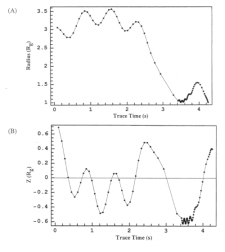 |
Figure 6.18 (A) Length of the radius vector from the center of Ganymede to the particle as a function of trace time in seconds for subenergy 400 keV sublook direction 5 for model 1 channel A4. Ten points comprise a gyroperiod. (B) The Z component of the particle position in GSII coordinates for subenergy 400 keV sublook direction 5 for model 1 channel A4. |
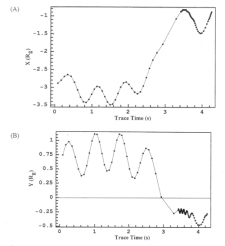 |
Figure 6.19 (A) The X component of the particle position in GSII coordinates as a function of trace time in seconds for subenergy 400 keV sublook direction 5 for model 1 channel A4. Ten points comprise a gyroperiod. (B) The Y component of the particle position in GSII coordinates as a function of trace time in seconds for subenergy 400 keV sublook direction 5 for model 1 channel A4. Ten points comprise a gyroperiod. |
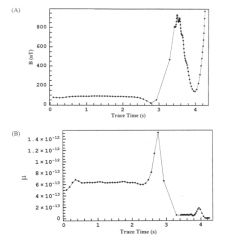 |
Figure 6.20 (A) Magnetic field at the location of the particle as a function of trace time for subenergy 400 keV sublook direction 5 for model 1 channel A4. (B) Magnetic moment at the location of the particle as a function of trace time for subenergy 400 keV sublook direction 5 for model 1 channel A4. |
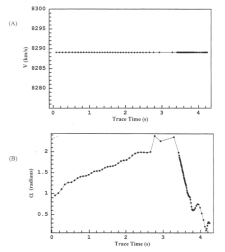 |
Figure 6.21 (A) Velocity of the particle as a function of trace time for subenergy 400 keV sublook direction 5 for model 1 channel A4. (B) Pitch angle of the particle as a function of trace time for subenergy 400 keV sublook direction 5 for model 1 channel A4. |
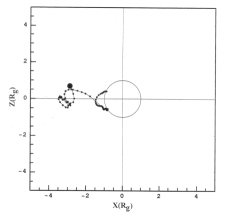 |
Figure 6.22 ZX projection of the trajectory for subenergy 400 keV sublook direction 5 for model 1 channel A4. |
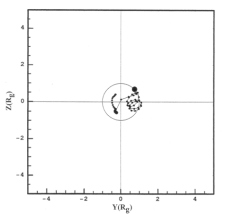 |
Figure 6.23 ZY projection of the trajectory for subenergy 400 keV sublook direction 5 for model 1 channel A4. |
These types of null point interactions are also present in the model M2 simulated inbound data for the ions. Figure 6.24 shows an example of one of these null features for G2-18:48:11 channel A6. At about 18:48:12 a set of slivers appears very nearly matching the real data. The point shown in Figure 6.24a (designated by an arrow) is broken down into its individual trajectories from which a collimator pitch and phase scatter plot is constructed for the subenergy 1110 keV; see Figure 6.25. It is clear from this plot that this feature is not ordered by pitch or phase. The nature of this feature can also be investigated by the investigation of a trajectory that hit (sublook 5) and a trajectory that missed (sublook 7).
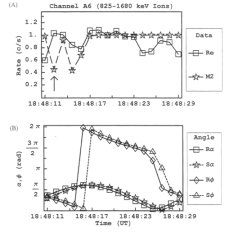 |
Figure 6.24 (A) Simulated M2 and real (Re) rate profile for feature G2-18:48:11 of Channel A6 normalized to 90º of pitch. The arrow points to a data point that will be broken down for further analysis. (B) The pitch and phase angles are computed from the look direction of the EPD detector and the appropriate magnetic field vector R for real and S for simulated. |
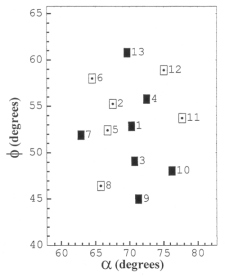 |
Figure 6.25 Collimator pitch and phase scatter plot for the sector pointed out in Figure 6.24 for M2 A6 G2-18:48:11 subenergy 1110 keV. The angles are in degrees. The filled in squares represent trajectories that intersected the surface of Ganymede and were absorbed. Open squares represent trajectories that missed. |
Return to dissertation table of contents page.
Return to main
Galileo Table of Contents Page.
Return to Fundamental
Technologies Home Page.
Updated 8/23/19, Cameron Crane
QUICK FACTS
Mission Duration: Galileo was planned to have a mission duration of around 8 years, but was kept in operation for 13 years, 11 months, and 3 days, until it was destroyed in a controlled impact with Jupiter on September 21, 2003.
Destination: Galileo's destination was Jupiter and its moons, which it orbitted for 7 years, 9 months, and 13 days.



